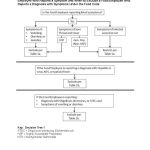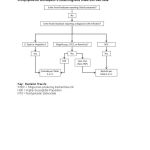Exclusion and Restrictions: Understanding Employee Health and the Food Code
I received a call earlier in the month from a foodservice operator who suspected that one of their employees may have fallen ill and wondered if they had to send the employee home for the day. Once I started to ask a few more questions, it became obvious that the operator wasn’t really in-tune with the food code requirements on restrictions or exclusions for employees who may not be feeling well. Given that most operations are dealing with staff shortages currently and the fact that we are about to head into the fall and winter – when we tend to see an increase in upper respiratory and other illnesses, such as the flu – it seemed like a very timely and important topic for the blog this month.
Did you know that depending on the symptoms displayed by the employee, even a hangover can mean that an employee should be excluded from the operation, while Hepatitis B and C are not a reason to exclude?
Did you know that depending on the symptoms displayed by the employee, even a hangover can mean that an employee should be excluded from the operation, while Hepatitis B and C are not a reason to exclude? Restrictions and exclusions are often touched on in food safety training, but I am not sure the average employee or manager who sits through the class really internalizes this information. To ensure everyone is on the same page with what an exclusion is versus a restriction, an exclusion is when the employee is not allowed to enter or work in the food service operation, with no exceptions. On the other hand, a restriction is when the employee can work in the establishment but is restricted to only tasks that do not involve food or clean equipment, utensils, or linens. A few of the FDA recommended tasks that employees who are restricted can do include cashiering, seating guests, bussing tables, or working in non-food cleaning/maintenance tasks. However, I would caution you to use your best judgment in decided what tasks a restricted employee can do in your foodservice operation. Even if the FDA indicates a restricted employee can complete a task, you need to consider what the job entails in your specific operation. For example, if a cashier seats the guest and brings them beverages in your foodservice operation, as they did in ours, it is not an acceptable task for someone who is restricted to be doing.
The easiest decisions to make are when the employee is experiencing symptoms and is diagnosed with Hepatitis A, Nontyphoidal Salmonella, Shigellosis, Norovirus, or Shiga toxin-producing Escherichia coli (STEC) or when the employee is reporting vomiting, diarrhea, or jaundice. In each of these cases, regardless of the type of population served by the foodservice, the employee should be excluded. However, when simply looking at symptoms, such as a sore throat and fever, the employee can be restricted if working with the general population but should be excluded if the foodservice organization serves a highly susceptible population[1]. But then if the employee is reporting none of the symptoms but has been diagnosed with certain infections (in other words, they are asymptomatic) such as Shigella, STEC, or Norovirus, and does not work with a highly susceptible population, a restriction would suffice. However, that same employee working with highly susceptible populations should be excluded. Clear as mud, right?
If in doubt, there are many great resources online for you to use. Bookmark this page and come back to it when you need to know the details. I’ve included the decision trees straight from the food code to help you decide which applies in your situation. Decision Tree 1 illustrates when to exclude or restrict employees who report symptoms and when to exclude an employee who has been diagnosed with symptoms in the food code. Decision Tree 2a illustrates when to exclude or restrict an employee who is asymptomatic but has been diagnosed with a foodborne illness. Decision Tree 2b illustrates when to restrict an employee who has simply been exposed to a foodborne illness.
A few other great resources I ran across that you might find helpful is the Food Employee Illness Guidelines document put out Minnesota Department of Health and the Food Employee Foodborne Illness Exclusion Guidelines published by the Multnomah County Health Department. However, I would be remiss if I didn’t remind you to check in with your local health department and inspector. Remember, each state, county, and city could have different guidelines. While this information is all based on the FDA current food code (2017), it is important to ensure that your state doesn’t have stricter regulations which you must follow.
As a person in charge in the foodservice operation, it is your duty to exclude or restrict an employee to prevent the spread of foodborne illnesses. The regulatory authority can also exclude or restrict an employee, but you as the manager are on the frontlines each day and have the responsibility to ensure your employees health is up to par and you are protecting the public.
Don’t forget to check out our most recent SafeBites Webinar, “A Foodservice Operators’ Guide to the Food Code”, which will be posted in early December! If you have any topics you’d like us to address in 2023, please reach out and let me know. Risk Nothing.
[1] Defined in the FDA Food Code as those who may be, “1. Immunocompromised; preschool age children, or older adults; and (2) Obtaining FOOD at a facility that provides services such as custodial care, health care, or assisted living, such as a child or adult day care center, kidney dialysis center, hospital or nursing home, or nutritional or socialization services such as a senior center”.
READ MORE POSTS
A Fresh Start: Recommitting Yourself and Your Business to Food Safety in 2024
As we get settled into the new year and leave the hustle and bustle of the [...]
Dry Food Storage – How Vital is it to Food Safety?
Whichever you decide, because some jurisdictions have more stringent requirements than the conference for food protection, check with your local health department to make sure they also recognize the exam before you pay for it.
Navigating a Power Outage in Your Foodservice Operation
In the Midwest this year, it seems storms are occurring weekly. Perhaps this is the norm, [...]
Using Artificial Intelligence to Strengthen your Food Safety Program
In many facets of our lives today, we see technology driving innovation and changes that 25 [...]












